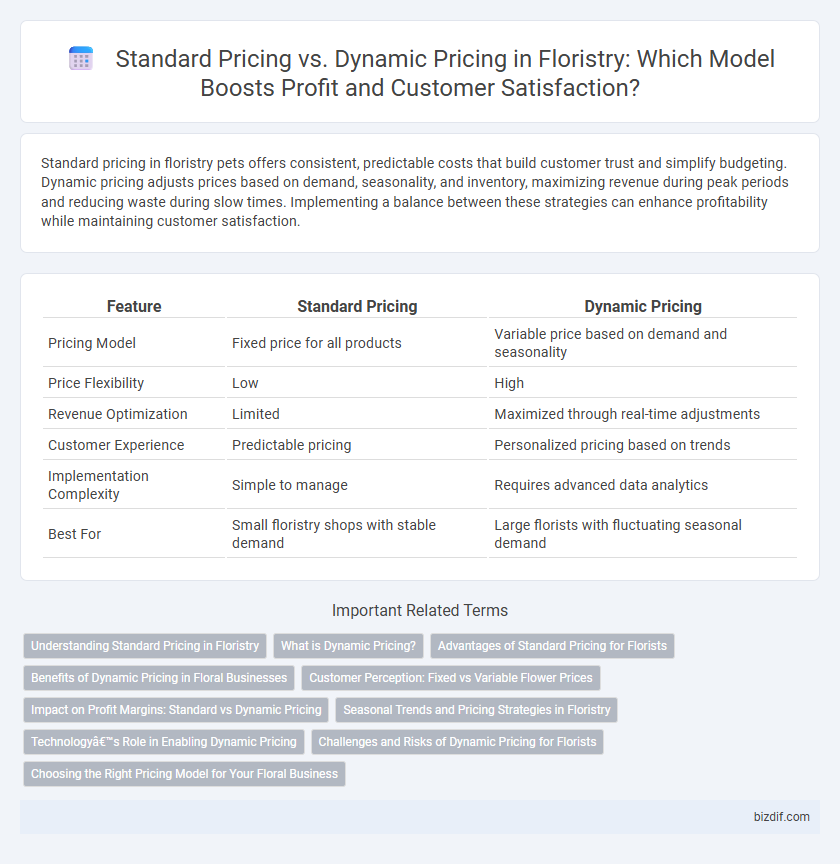Standard pricing in floristry pets offers consistent, predictable costs that build customer trust and simplify budgeting. Dynamic pricing adjusts prices based on demand, seasonality, and inventory, maximizing revenue during peak periods and reducing waste during slow times. Implementing a balance between these strategies can enhance profitability while maintaining customer satisfaction.
Table of Comparison
| Feature | Standard Pricing | Dynamic Pricing |
|---|---|---|
| Pricing Model | Fixed price for all products | Variable price based on demand and seasonality |
| Price Flexibility | Low | High |
| Revenue Optimization | Limited | Maximized through real-time adjustments |
| Customer Experience | Predictable pricing | Personalized pricing based on trends |
| Implementation Complexity | Simple to manage | Requires advanced data analytics |
| Best For | Small floristry shops with stable demand | Large florists with fluctuating seasonal demand |
Understanding Standard Pricing in Floristry
Standard pricing in floristry involves setting fixed prices for floral arrangements and services based on factors like flower types, arrangement complexity, and labor costs. This pricing model ensures consistency and predictability for customers, making budget planning easier for both the florist and clients. By relying on steady market prices for flowers and overhead expenses, florists maintain stable profit margins without frequent price fluctuations.
What is Dynamic Pricing?
Dynamic pricing in floristry is a strategy where flower prices fluctuate based on real-time factors such as demand, seasonality, and inventory levels. This approach allows florists to maximize profits during peak occasions like Valentine's Day or Mother's Day by adjusting prices accordingly. Unlike standard pricing, dynamic pricing responds to market trends and consumer behavior, optimizing revenue and reducing waste.
Advantages of Standard Pricing for Florists
Standard pricing in floristry ensures price consistency and simplifies budgeting for both florists and customers, fostering trust and repeat business. It reduces administrative overhead by minimizing the need for constant price adjustments and customer negotiations. This predictable pricing strategy helps florists maintain stable profit margins and effectively manage inventory without frequent fluctuations.
Benefits of Dynamic Pricing in Floral Businesses
Dynamic pricing in floral businesses maximizes revenue by adjusting prices based on real-time demand fluctuations, seasonal trends, and inventory levels. This approach minimizes waste by encouraging sales during low-demand periods and capitalizes on high-demand occasions such as weddings and holidays. Leveraging data analytics and customer purchasing patterns, dynamic pricing enhances competitive advantage and improves profit margins in the floristry market.
Customer Perception: Fixed vs Variable Flower Prices
Standard pricing in floristry offers customers a predictable cost for flowers, fostering trust through price transparency and consistency. Dynamic pricing adjusts flower prices based on demand, seasonality, or inventory, which may create a perception of flexibility but can also lead to confusion or dissatisfaction among buyers seeking stable prices. Consumers often favor fixed pricing for routine floral purchases to avoid unexpected costs, while dynamic pricing appeals in peak seasons or for rare blooms where willingness to pay varies.
Impact on Profit Margins: Standard vs Dynamic Pricing
Standard pricing in floristry offers predictable profit margins by maintaining consistent prices, which simplifies cost management but may miss opportunities for higher revenue during peak demand; dynamic pricing adjusts flower prices in real-time based on factors such as seasonality, event dates, and market trends, maximizing profit margins through optimized pricing strategies. Florists using dynamic pricing can respond to supply fluctuations and customer urgency, potentially increasing profitability during high-demand periods like Valentine's Day or Mother's Day. However, dynamic pricing requires sophisticated data analysis and customer sensitivity to prevent alienation, whereas standard pricing provides stability and ease of communication.
Seasonal Trends and Pricing Strategies in Floristry
Floral businesses utilize standard pricing to maintain consistent rates throughout the year, focusing on established costs for popular arrangements and common flowers. Dynamic pricing adjusts costs in real-time, reflecting seasonal trends such as increased demand during holidays like Valentine's Day and Mother's Day, enabling florists to maximize revenue. Effective pricing strategies incorporate market analysis, flower availability, and customer buying patterns to balance profitability with competitive positioning in the floristry industry.
Technology’s Role in Enabling Dynamic Pricing
Technology plays a crucial role in enabling dynamic pricing in floristry by utilizing real-time data analytics and AI algorithms to adjust flower prices based on demand, seasonal trends, and inventory levels. Advanced pricing software integrates with sales platforms to monitor market conditions and customer behavior, allowing florists to optimize revenue while reducing waste. This shift from standard pricing to dynamic pricing enhances competitiveness and responsiveness in the floral industry.
Challenges and Risks of Dynamic Pricing for Florists
Dynamic pricing in floristry presents challenges such as customer confusion and perceived unfairness when prices fluctuate frequently based on demand or seasonality. Florists risk alienating loyal customers by implementing fluctuating prices, which can undermine trust and brand loyalty. Additionally, managing inventory becomes complex as rapid price changes can lead to overstocking or shortages, impacting overall profitability.
Choosing the Right Pricing Model for Your Floral Business
Standard pricing offers consistent rates that simplify budgeting and build customer trust, making it ideal for floral businesses targeting steady sales and repeat clients. Dynamic pricing adjusts costs based on demand, seasonality, or special events, maximizing profits during peak periods like Valentine's Day or Mother's Day. Selecting the right model depends on market conditions, customer expectations, and inventory flexibility to balance competitiveness with revenue optimization.
Standard Pricing vs Dynamic Pricing Infographic

 bizdif.com
bizdif.com